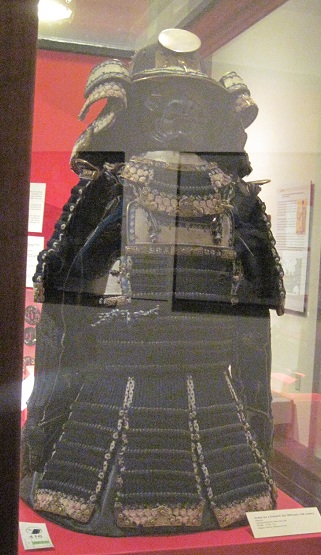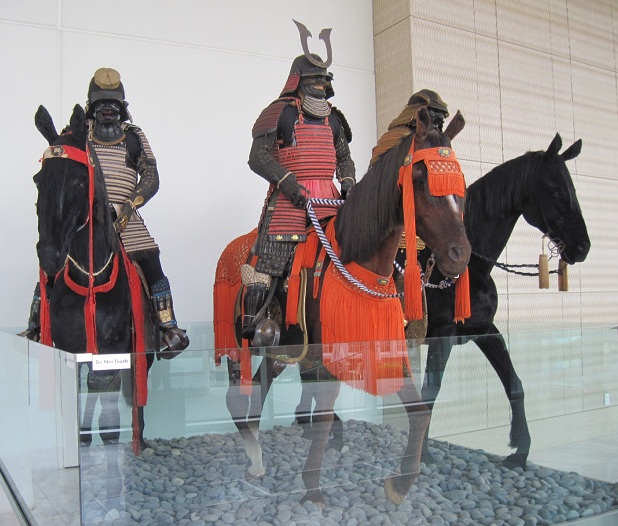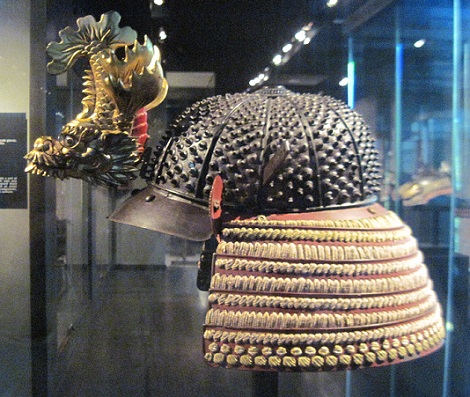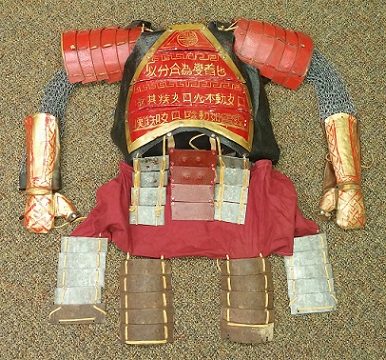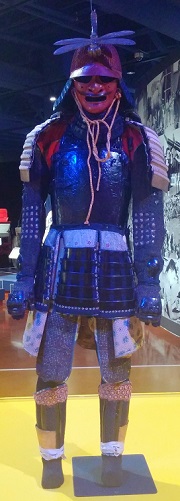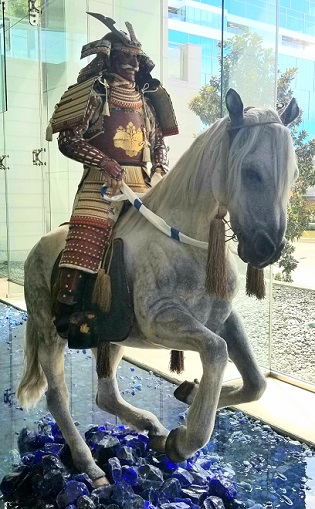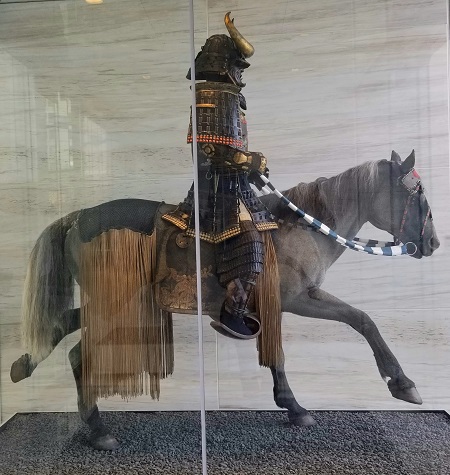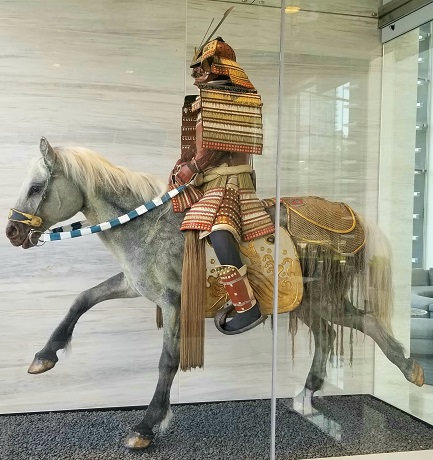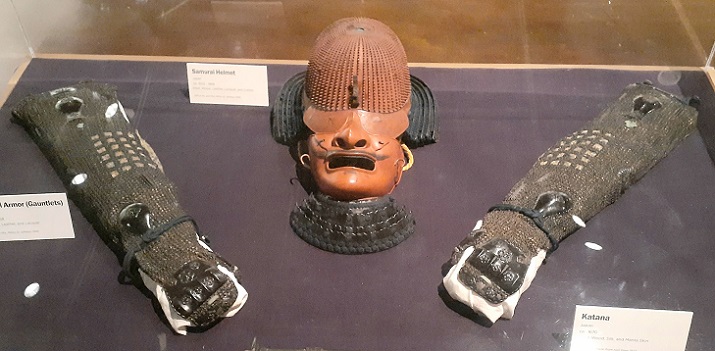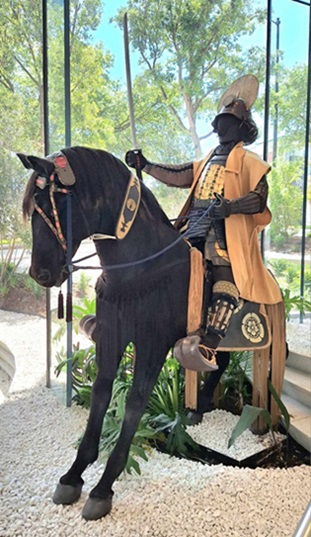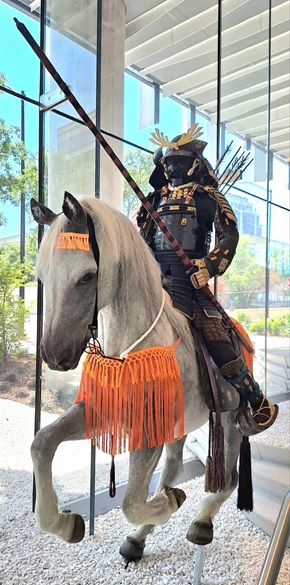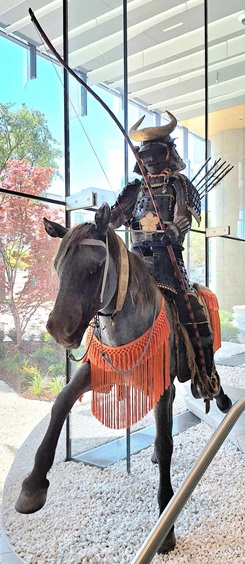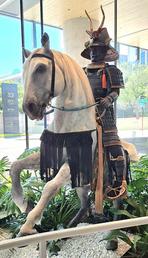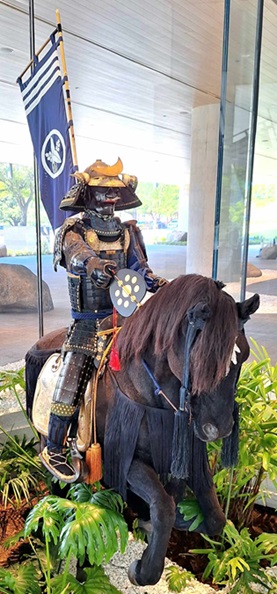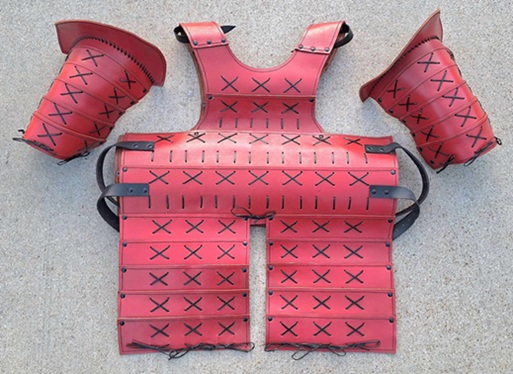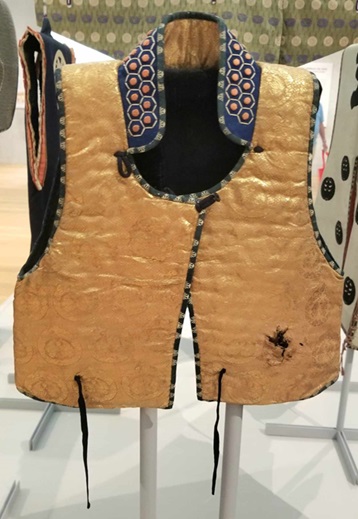Subject: 侍 samurai warrior
Culture: Japanese
Setting: Tokugawa shogunate, Japan 17th-mid 19thc
Object: armor = 兜 kabuto helmet; gusoku, haramaki cuirass; manjuwa vest
Fort Worth Museum of Science and History > Transformation of Weaponry *
"Samurai Helmet Japan ca. 1603-1868 Steel, Wood, Leather, Lacquer, and Cotton" ...
"Samurai Armor (Gauntlets) Japan ca. 1603-1868 Steel, Wood, Leather, and Lacquer" ...
* Metropolitan Museum of Art > Stone Gallery of Arms and Armor
"Armor of the Gusoku type Laquered iron, shakudo, silver, silk, horse hair, and ivory Edo Period, 18th century
The workmanship of this armor and its materials are all of the highest quality. It is possibly the only surviving example of a Japanese armor with this color sheme of silk lacings. The mon, in the form of three whirling commas (mitsudomoe mon) is that of the Obake family, feudal lords of Kishiwada (present day Kishiwada City in Osaka Prefecture). The armor is signed on the inside of the helmet: Eichizan nonkuni Toyohara jū Bamen Tomotsugusaku (Bamen Tomotsugusaku living in Eichizan province, Toyohara village). Bamen Tomotsugusaku was the leading armorer of the Bamen school in the 18th century. Complete armors signed by him are extremely rare."
2801 Harwood *
* Metropolitan Museum of Art > Stone Gallery of Arms and Armor
"Armor (Gusoku)
Lacquered iron, mail, silk, gilt copper
Edo period,
16th and 18th centuries
This example comes from the armory of Daté Yoshimura (1703-1746), daimyo of Sendai. The helmet bowl, signed Saotome Iye[tada?], dates from the sixteenth century; the remainder of the armor was constructed in the eighteenth century. The breastplate is inscribed inside with the armorer's name Myōchin Munesuke (1688-1735). The embossed ornament on the solid iron plates is characteristic of the Myōchin school."
2801 Harwood *
* Metropolitan Museum of Art > Stone Gallery of Arms and Armor
"Armor (Gusoku)
Lacquered iron, mail, silk, gilt copper
Helmet and mask inscribed by Jo Michitaka
Edo period,
19th century
This armor bears the wisteria badge of the Ōkubo family, daimyo of Karasuyama." ...
2801 Harwood *
* Metropolitan Museum of Art > Stone Gallery of Arms and Armor
"Armor (Haramaki)
Laquered iron and leather, mail, gilt copper, silk, hair
Edo period,
late 18th-19th century"
2801 Harwood *
* Metropolitan Museum of Art > Stone Gallery of Arms and Armor
"Armor (Gusoku)
Lacquered iron, mail, silk, gilt copper Edo period, 18th century
The cuirass and shoulder guards (sode) formed of large iron plates
rather than traditional lamellae (small, narrow iron plates) reveal European influence and
the concurrent introduction of firearms, which necessitated solid, bulletproof places."
2801 Harwood *
Roman Museum *
* Metropolitan Museum of Art > Stone Gallery of Arms and Armor
"Armor (Gusoku)
Lacquered iron, mail, silk, gilt copper Edo period, 18th century
The large iron plates, embossed with dragons and cherry blossoms,
are signed by the armorer Myōchin Munesuke (1688-1735)."
Kimbell Art Museum > Passport to Asia
"Manjuwa Japan, Edo period (1603-1868) Silk brocade The manjuwa, a short vest without sleeves,
offered supplemental protection under armor. Though its gold brocade would have been hidden,
the choice of decorative motifs on this example was appropriate for the battlefield:
confronting dragons are images of power inherited from China;
the tortoiseshell design embroidered on the collar is a wish for long life;
and the tiny irises on the trimming are symbols of fidelity in accordance with the samurai code."
* Metropolitan Museum of Art > Stone Gallery of Arms and Armor
"Cuirass (Hara-Ate)
Lacquered iron and leather, silk laces, gilt
copper, stenciled leather
Edo period,
18th century"
* Metropolitan Museum of Art > Stone Gallery of Arms and Armor
"Armor (Tatami Gusoku)
Lacquered iron, mail, silk, gilt copper
Edo period,
17th-18th century
Armor of the 'folding' (tatami) type could be contained in a small box and easily transported by one man.
For this reason, it was usually intended for low-ranking infantrymen.
The gold lacquer decoration and silk brocade lining of this example are unusual for armors of this type, however.
They suggest that it was used by a samurai serving the Daté family of Sendai, from whose armory it comes."
* Metropolitan Museum of Art > Stone Gallery of Arms and Armor
"Armor for a Mounted Samurai
Lacquered iron, mail, silk, gilt copper
Edo period,
18th-19th century
This armor was intended for a high-ranking officer in the service of the Mōri family, a daimyo of Chōshū whose badge is incorporated into the armor's gilt metal fittings. The figure wears a tachi, or slung sword, the scabbard of which is covered with leopard skin, a fashion that looks back to the fourteenth century. The horse is mounted with a lacquered saddle and silver-inlaid stirrups, an iron bit signed by Myōchin Sadahisa, and a rare set of ceremonial braids covering the horse's flanks."
* Metropolitan Museum of Art > Stone Gallery of Arms and Armor
"Armor (Gusoku)
Iron, mail, silk, gilt copper
Late Edo period,
early to mid-19th century
This armor was assembled in the nineteenth century and reflects several waves of Western influence on Japan. The helmet follows the shape of a late sixteenth-century Dutch cabasset but is a contemporary copy by the Japanese armorer Saotome Iyetada, whose signature is found inside the bowl. The cuirass appears to be of early nineteenth-century European manufacture. These older elements, completed by more modern ones, were decorated with Buddhist divinities and literary figures rendered by a Japanese craftsman using a Western process, etching. The helmet bears the badge of the Arima family, daimyo of Kurume."
* Royal Ontario Museum > Takamado Gallery of Japan
"Armure complete
Fer laque, lacage de soie, peau de daim, cuivre dore grave
v. 1800, epoque Edo"
* Museu do Oriente > Presença Português na Asia
"ARMADURA RYO TAKAHIMO RENJAKU DO
Japão,
período Edo (1615-1868),
século XVII
Ferro, laca, ouro, papel lacado, linho, algodão, seda, tela, serapilheira, couro pintado, camurça estampada e corno (botões). Madeira (caixa)
O termo samurai, entendido não na acepção individual do guerreiro japonês mas relativo a uma classe guerreira, reporta-se a um corpo de guerreiros vassalos de um chefe militar (daimyō ou shōgun). O vocábulo deriva do verbo sabarau, que significa servir. O prestígio granjeado pelos samurai, que se afirmaram no context da história japonesa como uma elite militar e, a partir do período Edo, como uma espécie de aristcracia guerreira, teve repercussões em todos os acessórios que lhes estão directamente associados, sobretudo as armaduras e as armas.
* Museu do Oriente > Presença Português na Asia
"ARMADURA DO TIPO KARUTA GANE TATAMI DO
Japão,
período Edo (1615-1686 [SIC]), século XVIII
Metal (ferro) lacado, latão, linho e lã, algodão (fitas e enchimento), seda, tela, camurça estampada, corno (botões). Bambu (caixa)
Armadura reveladora de persistência de modelos mais antigos, insere-se no tipo designado por karuta gane tatami do. A tradução desta designação -- couraça dobrável de placas rectangulares (que, neste caso, não apresentam contudo um padrão geométrico único) -- revela uma das características mais importantes deste modelo: o facto de utilizar cordões apenas pontualmente.
* Museu do Oriente > Presença Português na Asia
"CAIXA E ARMADURA DO TIPO HON IYOZANE NUINOBE DO
Japão,
período Edo (1615-1868), séculos XVII-XVIII
Ferro, latão, laca, tecido de linho, lã, algodão, seda, tela, camurça estampada, corno (botões). Madeira e couro (caixas). ...
Este exemplar inclui-se no tipo de armadura designada por hon iyozane nuinobe do, o que significa que o peito da armas (do) é constituído por duas partes unidas através de uma dobradiça sob o braço esquerdo (ni mai do), sendo formado por lâminas dispostas quase sem sobreposição
(iyozane) e unidas por pares de cordões atados verticalmente (técnica de atar sugoke).
(sashimono), com vista à rápida e eficaz identificação dos soldados."
* Metropolitan Museum of Art > Stone Gallery of Arms and Armor
"Masks
Masks have long played an important role in Japanese culture: in religious ceremonies, dance, Noh theater, and also military tradition. For the samurai, the mask served as the principal face defense and helped to secure the helmet more firmly to the head. The fierce, grimacing expressions and the large beaked noses were intended to strike fear in an opponent. The majority of masks were half-length (mempo or menoshita-hooate), covering the nose and the face below the eyes.
* Metropolitan Museum of Art > Stone Gallery of Arms & Armor
"Armor (Gusoku)
Lacquered ron, mail, silk, gilt copper
Inscribed by Yukinoshita Sadaiyé
Edo period,
17th century
The helmet is mounted with the crest of the Daté family, daimyo of Sendai."
* Metropolitan Museum of Art > Stone Gallery of Arms and Armor
"Helmet in the Shape of a Sea Conch
Iron, with gold and silver inlay
Edo period,
17th century"
* Metropolitan Museum of Art > Stone Gallery of Arms and Armor
"Helmet (Zunari Kabuto)
Lacquered iron, silk, gilt copper
Edo period, 17th-18th century
The bowl is shaped like the top of a human head (zunari). The presence of three crests is unusual: at the front, a sun; at the sides, horns; and at the apex, a double-edged sword."
* Metropolitan Museum of Art > Stone Gallery of Arms and Armor
"Helmet in the Shape of a Crouching Rabbit
Lacquered iron, silver, gold, leather, silk
Edo period,
17th century"
* Tropenmuseum > Nederlands-Indië
* Higgins Armory Museum > Scimitars to Samurai: Arms around the World
"Armor for a Samurai,
late 18th/early 19th century
Japanese
Lacquered leather; brass; iron; silk
Weight: 23 lbs., 1 oz." ...
* Harwood International Center > Saint Ann
"SAMURAI: MOUNTED WARRIORS from The Ann & Gabriel Barbier-Mueller Museum
Samurai armor: Tachidō tōsei gusoku (suits of armor) Momoyama period (c. 1580) to Edo period, mid-18th century Iron, lacquer, gold, bronze, copper, lacing, bear fur
Horse tack: Bagu (horse tack sets), with kura (saddles) and abumi (stirrups) Edo period (1603-1868) Iron, gold, wood, leather, silk, lacquer ...
Samurai were the elite military class of preindustrial Japan who controlled the country for almost a millennium. Originally mounted warriors in a feudal society, samurai lived to serve their daimyo, or lord. A samurai's armor not only protected the warrior, but helped establish their individual identity. The suit in the center with red lacing is unique, as are all samurai armors, with moth-like crests known as mon that symbolize a particular family or clan.
* Harwood International > Samurai Collection
"Maedate (frontal crest for a helmet) Late Edo Period, late 19th century Wood, lacquer, gold, glass, metal
This fish-like creature is known as shachihoko, an animal from Japanese folklore with the head of a tiger and body of a fish. The shachihoko, as well as the fish, had a great deal of symbolism for samurai including freedom, fearlessness, and protection. As a maedate, this creature would have been the focal point of a helmet, secured above the visor wit ha capture for the iron post that is attached at the back of the fish."
*
> event photos
* Fort Worth Museum of Science and History > Hidden Treasures: Celebrating 75 Years
"SAMURAI ARMOR
This authentic armor is typical of those used in battle in the 16th and 17th centuries.
Its purpose was to protect warriors and intimidate enemies.
Worn by Japanese knights, it symbolized courage and indicated social class." ...
* Harwood International > Azure
"SUIT OF ARMOR AND SADDLE SET
SUIT OF ARMOR SIGNED MIOCHIN MUNEHARU Japan, 19th century in the style of the 16th century Iron, laquer, silver, gold, silk
BAGU (SADDLE) SET SIGNED NAGAMUNE Japan, 1675 Wood, laquer, gold, iron, silk
This armor would have been worn by a Japanese samurai warrior: A Buddhist deity in silver and gold overlay decorates the front. The face is protected by a menpo (half mask) made of lacquered iron with red lips and a hair moustache.
The wooden saddle is signed with the skilled maker's name, Nagamune, and dated in the seventh month of the year 1675. It is elegantly lacquered in black with a design of butterflies in gold. The shape of the stirrups with their broad flat base was designed to allow the rider to stand when fighting, particulary [SIC] when shooting with the bow. Samurai were skilled marksmen who lived by the bushido code of honor." ...
* Harwood International > Bleu Ciel
"Dark Horse: Yokohaidō armor and bagu (horse tack) Japan Edo period, 1615-1868 Iron, lacquer, silk, wood, horn, silver, gold, leather ...
Light Horse: Gusoku armor and bagu (horse tack) Japan Edo period, 1615-1868 Iron, lacquer, silk, wood, horn, silver, gold, leather, hair ...
Samurai were the warrior elite of Medieval Japan. Besides serving as the military, they acted as the country's government from the years 1185 to 1868 and left a lasting impact on Japan's culture and history. The riders wear armor created from many plates of black or red lacquered iron that have been laced together with silk cord. The armor is relatively light and flexible, allowing the highly-skilled samurai full range of motion. The neck guard that hangs down from the helmets, when used together with the broad shoulder guards, functioned as a shield. If there were incoming arrows, the samurai would turn their should into the volley and let their armor take the impact.
"Samurai were originally mounted archers and horses, prized for their strength and speed, played an important role in warfare throughout the samurai era. The warriors' martial code was known as 'kyūba no michi' -- the way of the horse and bow.
"The iron stirrups on these horses would have provided a wide platform that the samurai could stand on to fire their bow at a gallop.
"Beyond warfare, horses helped to protect Shinto shrines. In the Momoyama period (1573-1615), shrines would keep two horses, one light colored and one dark -- represented in the entranceway by the white and black fiberglass horse mannequins. In Shinto belief, the horses worked together to help control the weather. The dark horse could cause rain to fall and teh light one brought teh sun. As time passed, shrines replaced the acutal animals with sculptures or paintings of light and dark horses." ...
